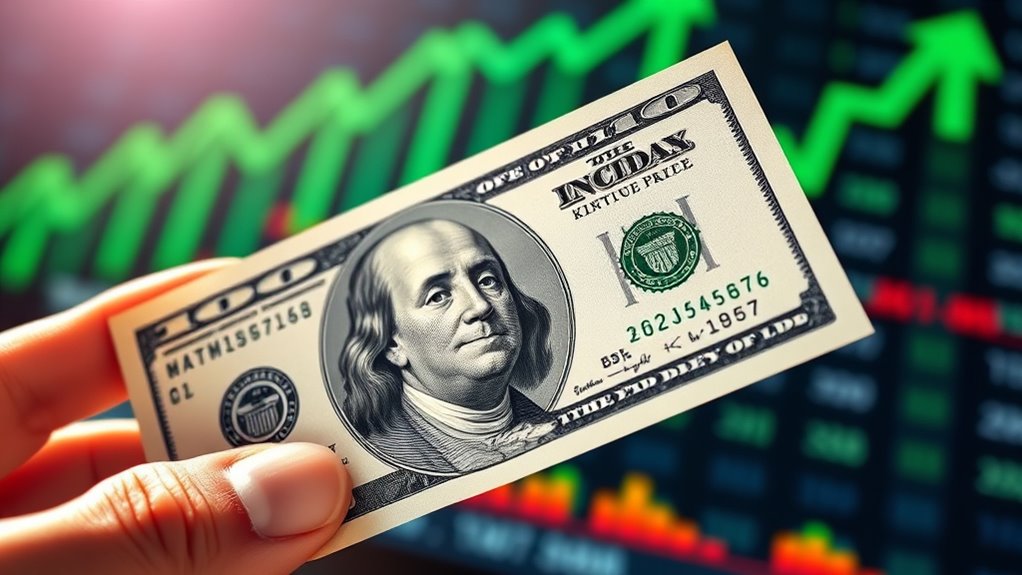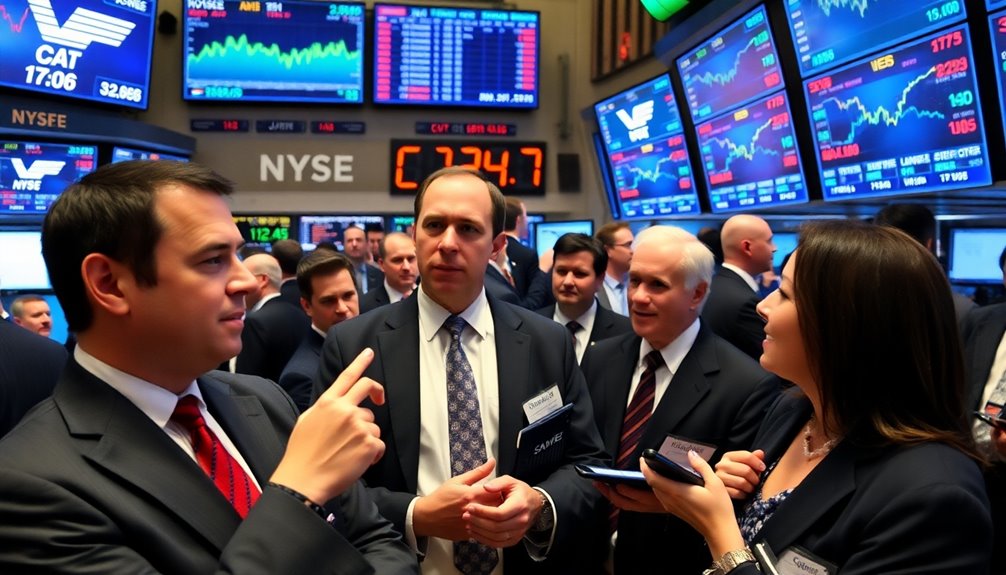The rise in the July producer price index signals ongoing inflation pressures, causing the dollar to strengthen as investors bet on tighter monetary policy. Wholesale prices jumped sharply, driven by higher service costs, food, and energy prices. This broad-based inflation suggests the Fed may hold or even hike rates, boosting dollar confidence. If you want to understand how these inflation signals could influence your investments or currency trading strategies, there’s more to explore below.
Key Takeaways
- The July PPI rose 0.9% MoM, signaling stronger inflation pressures, boosting confidence in the dollar’s strength.
- Persistent wholesale price increases suggest ongoing inflation, encouraging investors to favor the US dollar.
- Elevated input costs and broad-sector price gains reinforce expectations of tighter monetary policy, supporting the dollar.
- The dollar index remained above 98.00, reflecting market optimism about sustained inflation and potential rate hikes.
- Stronger inflation signals from wholesale data led to increased investor demand for the US dollar.

The U.S. dollar strengthened following a significant jump in the Producer Price Index (PPI) for July, signaling persistent inflation pressures that could influence monetary policy. You’ll notice that the overall PPI for final demand rose by 0.9% month-over-month, marking the strongest monthly gain since 2022. Annually, the PPI increased by 3.3%, surpassing expectations of 2.5% and June’s 2.4%. Excluding food, energy, and trade services, the core PPI also climbed 3.7% year-over-year, up from 2.6% in June. This sharp increase indicates that inflationary pressures are intensifying upstream, which can eventually trickle down to consumer prices. The data underscores the broad-based nature of inflation, with multiple sectors experiencing price increases. The drivers behind this surge are notable. Service prices jumped 1.1% in July, driven mainly by wholesale and retail margins rising around 2%. Food prices contributed roughly 40% of the total goods price gain, with vegetable costs seeing significant increases. Petroleum, alcohol wholesaling, nonferrous scrap, and data processing services also experienced price rises, adding to higher input costs for producers. Stage 1 intermediate demand prices, which reflect input costs for manufacturing, rose 1.1%, the largest increase since August 2023. Sectors like security brokerage, investment advice, courier services, diesel fuel, and traveler accommodations saw notable price hikes, further fueling the inflationary outlook.
The July PPI surge signals persistent upstream inflation pressures impacting consumer prices and monetary policy outlooks.
These developments complicate the Federal Reserve’s stance. The strong wholesale inflation signals that inflation pressures remain stubbornly high upstream, making rate cuts less likely in the near term. Higher input costs have a ripple effect, potentially pushing consumer prices upward and prolonging inflation concerns. As market participants digest these figures, expectations for a stronger U.S. dollar grew, especially ahead of upcoming economic data releases. The currency responded positively, with the US Dollar Index staying above 98.00, reflecting investor confidence that persistent inflation might warrant tighter monetary policies.
The market’s reaction shows an understanding that inflation isn’t easing as quickly as hoped. The dollar’s rise is also supported by resilient economic data, which reinforce the view that the U.S. economy remains strong despite inflationary headwinds. The surge in wholesale prices, driven by rising service and input costs, signals that inflationary pressures are broad-based, not just limited to consumer prices. Tariff-related pressures and increased production costs continue to push inflation higher, making the dollar’s strength a reflection of expectations for the Federal Reserve to maintain or even tighten rates to combat these persistent inflation signals.
Frequently Asked Questions
How Does the PPI Impact Consumer Inflation Expectations?
You see the PPI rise, and it impacts your inflation expectations by signaling higher costs for goods and services. When producer prices jump, you start to worry that retail prices will follow, leading you to expect inflation to increase soon. This concern influences your spending habits, making you more cautious or prompting you to buy now before prices go up. Businesses passing costs to consumers reinforce these inflation expectations.
What Sectors Contributed Most to the PPI Increase?
You should note that the services sector contributed the most to the PPI increase, driven by higher prices in transportation, brokerage, and accommodation services. Additionally, the food and unprocessed materials sectors saw significant jumps, with food prices rising 2.9%. Goods prices also increased, particularly in manufacturing and intermediate demand, largely due to higher energy and raw material costs. These combined factors pushed the overall PPI upward in July.
Will the PPI Rise Influence Federal Reserve Interest Rate Decisions?
Yes, the PPI rise will influence Fed interest rate decisions. You might think it’s just one report, but persistent inflation signals like this suggest the Fed could keep rates higher longer or even hike them. They’ll consider other data too, but rising producer prices, especially in essential sectors, imply inflation might stick around. So, expect the Fed to stay cautious, possibly delaying rate cuts or raising rates if inflation worsens.
How Does the PPI Affect Global Markets Beyond the USD?
You’ll notice that a rising PPI impacts global markets beyond the USD by increasing production costs worldwide. This can lead to higher prices for raw materials, which ripple through supply chains and raise consumer prices. Central banks may tighten monetary policy, affecting investments and currency values. Additionally, countries reliant on commodity exports may see their currencies fluctuate, and global trade becomes more uncertain as costs and inflation expectations grow.
Are There Seasonal Factors Influencing the July PPI Data?
Imagine a well-rehearsed dance troupe, each performer hitting their marks precisely—seasonal factors shape July PPI data just like that. They influence price movements through predictable patterns like mid-year demand drops or industry cycles. You see, these seasonal influences are baked into the data, helping to separate routine fluctuations from real inflation trends. So yes, seasonal factors are at play, subtly choreographing how prices shift in July.
Conclusion
You can see how the July PPI surge boosts the dollar, reflecting market confidence in inflation trends. For instance, if a company like WidgetCo anticipates higher production costs, it might raise prices, impacting consumer spending. Similarly, investors might see the dollar’s strength as a sign of economic resilience, prompting more investments. Staying aware of these shifts helps you understand how inflation data can directly influence your financial decisions and the broader economy.









